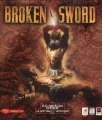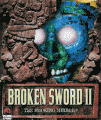Broken Sword: The Smoking Mirror
First posted on 31 December 1997. Last updated on 23 May 2014.
In the second installment of the Broken Sword series, the developer has taken the formula of success from Broken Sword: The Shadow of the Templars a step farther. Shifting from a focus on the legend of the Knights Templars, the new story revolves around the equally intriguing culture of the Mayan civilization in Central America. With superior graphics and a fair dose of original puzzles, Broken Sword: The Smoking Mirror (also called Broken Sword II: The Smoking Mirror) proves to be a worthy sequel.
Once again you assume the role of George Stobbart, an American adventurer who somehow got stuck in Paris. He is back in the capital of France hoping to reunite with his girlfriend Nicole Collard. Idle hope it seems. Nicole immediately engages him into a visit to an obscure Professor Oubier, an expert on Mayan art. Upon arrival at his house, Nicole gets kidnapped and George is tied to a chair, with a poisonous spider making his way to him and a fire preventing his escape through the front door. And here is where you start the game! A game that leads you from Paris to Marseilles, Quaramonte, the Caribbean, London and finally to the Mayan pyramids in Central American, with only a single goal—to stop the evil forces that seem to reside everywhere from freeing Tezcatlipoca, the evil Mayan god of thunder. You are about to get immersed into a plot of drugs traffic and other underworld activities. On your way to save the world from all this evil, you also meet lots of different characters that all, or at least most of them, are devious in some ways.
Broken Sword: The Smoking Mirror uses the same splendid game engine as its predecessor. The game interface includes a popup inventory at the bottom of the screen and a popup menu at the top of the screen. You just have to move your mouse into those regions for the respective menu to pop up. The game also improves on the main attraction that has made the original a success, namely its gorgeously rendered images. You will be stunned by the amount of details that are consciously rendered in each game screen. The characters move more fluidly throughout the game space, and thanks to the addition of shadowing, some more perspective is added. The latter may be the greatest improvement of all. When your character walks under a tree you will see the shadows of the leaves on him, giving a very realistic impression.
All the graphics are hand painted using cel animation techniques by artists formerly of Don Bluth Studios (All Dogs Go To Heaven, An American Tail, as well as the animation for the laser disc games Dragon's Lair and Space Ace). Over 50 characters and objects are animated separately and then overlaid on pre-rendered backdrops to allow for player control in real-time. In contrast, all cut scenes are pre-rendered as a whole entirely. The technical advances on the design of this game made include graduated shadows, 16 levels of transparency, geometric sprite transformation, alpha blending, and multiple parallax layers. The beautiful music is scored by BAFTA composer Barrington Pheloung (Nostradamus; Truly, Madly, Deeply). With 3 hours of original music and over 300 musical cues, the dynamic soundtrack swells and crescendos to heighten the drama of every move the player makes.
As with Broken Sword: The Shadow of the Templars, this sequel is the standard "pick up an item and use it somewhere else" or "manipulate this lever or that device to create that effect" adventure. Fortunately, thanks to the highlighting cursor, this affair never becomes tedious. For most of the time it is also quite obvious where you have to use a certain inventory object, thus avoiding the annoying process of trying every single object on every hotspot in order to make some progress in the game. Unlike the original title where Nicole and her apartment merely provide a link between the different game locations, Nicole plays an active role in this game. Once George has freed her from her kidnappers, you will alternate in playing the role of George and Nicole. Although there is a historical background in this game, the general tone is not too serious. By using some humor in the dialog, the game remains entertaining. Still, if you like to know more about the Mayan history, you are better off reading a history book!
On the high side, among the greatest achievements by the developer of this game is the very intuitive game interface. Even the less experienced adventure gamer can find the way in this game very easily. Equally stunning, but not surprising if you are already familiar with the original, are the graphics. Each game screen is drawn very meticulously with an eye for details, using an overwhelming amount of well chosen colors. The background music and sound effects greatly add to the general atmosphere of the game. The dialog is good and funny. It fulfills the function in giving you clues on what to do next. The cast of characters is well developed, including some great casting such as the evil General Grasiento and his domineering mother. You meet a variety of game characters who all tell you something interesting tidbits from their points of view or about their cultures. You also meet some old friends from the original game. My personal favorites are the misguided tourist Duane and the fisher boy Rico.
On the low side, Broken Sword: The Smoking Mirror is a very linear game. Whereas in the original title you have a choice of where to go and the opportunity to return to a particular spot when you discover that you have forgot something, in this sequel you have to finish all actions before you can proceed to the next location. This makes the gameplay a lot simpler and straightforward. As such, the game is indeed rather easy. It is hardly impossible to get stuck. Even with the harder obstacles you just can get through by trial and error. Diehard adventurer fans have to wait until the very end of the game for the only real puzzle in the game. I also feel that the addition of a maze (with very few logic in it) is merely used in this sequel as a game extender rather than an intrinsic part of the game plot. Sometimes I get bored by the amount of talking and running back and forth needed in order to trigger events. While the main storyline is based on Mayan civilization, it seems to be less well developed. On the other hand, you cannot expect a game to give you a full historical guided tour.
Whereas the original game supports both native DOS and Windows 95, this game supports only Windows 95. For the more technically inclined reader, I have encountered some incompatibility with DirectX throughout the game. On my system (a 233 MHz MMX with a DirectX compatible 2 MB Video board) I sometimes experience really annoying screen flickering. This is most certainly not caused by the hardware alone, since I have never faced this problem in other games that use DirectX.
All in all, I must admit that I really like this sequel. I also like the original, so may be this has biased my judgment a little. Simply stated, Broken Sword: The Smoking Mirror is among the best adventure games on the market. The storyline is enjoyable and the graphics are a pleasure for the eye. The dialog is to the point and, most of the time, rather funny. To conclude, the design team at Revolution Software has once again done a great job in delivering a worthy adventure.






